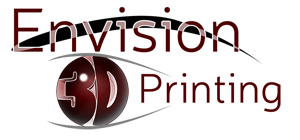Envision 3D Printing FAQs are written to help answer the most common questions our customers ask. If you have any questions that we did not cover, please send us an email at sales@envision3dprinting.com with your question, and we will answer your question as quickly as possible.
What is the largest part your machine can build?
For thermoplastic parts, our build envelopes are 14″L x 12″W and 14″L x 10″W x 14″H. For resin parts, our build envelope is 5.7″L x 5.7″W x 6.9″H. For our full color printer the build envelope is 10″W x 15″L x 8″H. Items that cannot fit into our build envelope can be printed in multiple sections and then bonded together. To facilitate assembly, pins and bosses can be incorporated into the mating surfaces.
What layer resolution (thickness) should I use to make my part?
While it would be easy to just make all parts with the best layer resolution of .005”, the major drawback to that approach is more time and, consequently, more money. The chart below shows the average increase in build time as build resolution increases when using ASA to print a 5” tall x 3” wide Minion Dave. If you are running a smaller part, especially one with finer details, .005” resolution would be a good choice. However, for most parts, .007” or .010” layer resolution suffices. If you’re unsure, Envision 3D Printing recommends .010″ as a default.
Note: Layer resolution of .005” is only available for ABS-M30, ABS-M30i , ASA and PC-ABS. The best layer resolution for ABS-ESD7, PC, PC-ISO, Nylon 12, and TPU 92A is .007”.
What interior part fill style should I use to make my part?
- Solid fill is only recommended if absolutely necessary for strength or if post machining will be done. This option adds a considerable amount of time and material to the build as shown in the chart below.
- Sparse fill is a good choice for models or parts that will be used for presentations or displays. This option uses the least amount of material and time, but it is also the least durable. If parts are small and/or have thin walls, they will print mostly solid.
- Double-dense sparse is a good compromise for added strength with a minimal increase in production time when compared to sparse. Envision 3D Printing recommends double-dense sparse as a default selection. Similar to sparse fill, if parts are small and/or have thin walls, they will print mostly solid.
Why use ASA over ABS material?
While ABS is a familiar and well-known material, ASA, which has been around for many years, is relatively new to FDM. Currently ASA for FDM is only offered for Stratasys printers. ASA has all the same benefits as ABS, plus it offers superior UV stability, yields a better surface finish, and can produce sparse-filled parts with less material and, consequently, less time. (ASA vs ABS comparison) In addition, Stratasys offers more color choices in ASA. While our machine is licensed to print both ABS-M30 and ASA, we have standardized on ASA. We can supply ABS-M30 if desired upon special request.
What type of files do you accept?
STL is the preferred file format for our thermoplastic and resin printers which both print in a single color. For our powder-bed full color printer we require a WRL or PLY file. If you do not have the option to create an STL, WRL or PLY file, then let us know what file format you have and we can help. File upload size is limited to 100 MB. For large STL files or files over the 100 MB limit, you can send a zip file.
Does Envision 3D Printing offer 3D drafting services?
We realize there are many people who need 3D printed parts but who do not have a 3D model to generate the print file. If you have a 2D drawing, or even just a sketch, and need a 3D model, we can generate it and the print file for you for an additional cost. To receive an estimate, send your drawing or sketch to sales@envision3dprinting.com.
How rapid is rapid prototyping?
When compared to conventional machining methods, rapid prototyping can be extremely quick. However, it can still take anywhere from several minutes to several hours to make a part, depending upon print parameters such as resolution and part density. We will work with you to minimize the print time for your part so we can save you time and cost.
How long does it take to make a part?
There are many part parameters that affect print time, such as layer resolution, part density, part size, material type, build orientation, and post-processing. In addition, customers’ parts are batch-processed by like resolution and material. Since additive manufacturing processes usually involve unique parts with limited quantities, managing the queue is a dynamic process. We make every effort to accommodate our customers as quickly as possible.
How are the parts delivered?
All orders will be shipped as quickly as possible via USPS, UPS, Fed-Ex or local courier. If you prefer local pick-up arrangements can be made. We service Houston and surrounding areas.
Does Envision 3D Printing offer price matching?
There are several printing parameters that affect price, and it is therefore difficult to determine if other service bureaus’ quotes are comparable. However, if you have a bid from a competitor that you think is too high, we welcome the opportunity to see if we can do better. You will typically find our prices are a good amount lower than our competitors.
What forms of payment do you accept?
For customers without an account, we accept PayPal or credit card. Payment for orders of $500 or less are due up front. For orders over $500, we charge 50% up front and 50% upon shipment.
